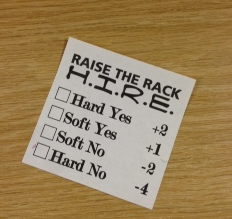What’s the single most important factor driving the success of a startup? A brilliant idea? Lots of investment capital? Nope. Great hiring.
The best idea, no matter how well funded, isn’t worth a thing without a team of smart, dedicated people who can work together effectively. And teams, like chains, are only as strong as their weakest link.
The wrong people drain the right people
Ask any manager who they want to spend the most time with and they will say their brightest, most promising employees. Then ask them who they actually spend the most time with. They’ll say their low performers. This paradox doesn’t just apply to managers though. The best engineers spend too much time debugging the code of lazy developers who (again!) didn’t fully test before rolling into production. The best support people spend too much time covering for their disorganized colleagues who (again!) didn’t follow up on their support tickets.
The wrong people always drain the right people, because the right people care and can’t let it go when everyone isn’t pulling their weight. Interventions (that’s a polite way of saying “firings”) are sometimes necessary to remove the wrong people, but in hiring like in health, an ounce of prevention is worth a pound of cure. So how do you create strong teams through hiring?
Tips for hiring great people
Rule #1- It’s much better to say ‘no’ to the right person, than ‘yes’ to the wrong one
In statistics there are two types of general errors: Type I and Type II (got to love a statistician’s sense of brevity!). A Type I error is a false positive. Type II error is a false negative. Both errors are bad, but when you are hiring, you want to avoid Type I errors at all cost. They are culture killers.
In hiring, a false positive is when you THINK an employee is a good fit, but in actuality they’re not. The rest of this post has some tips for recognizing false positives before they happen, but hiring the wrong person is so detrimental to a team’s success that you need to stack the deck against it ever happening. And you can do it with math. Here’s how it works.
Start with a good sized interview panel so you get as much perspective as possible. Around 8 people is perfect to interview a candidate (if your team is smaller than 8 people, just have everyone interview). At the conclusion of the interview, everyone should get together to discuss the candidate: the positives and negatives. Once the discussion is complete, everyone should vote in a secret ballot (this makes it easier for junior employees to vote their conscience without worrying about what their stupid boss wants) and a positive scores means that an offer can be extended. Negative score? Sorry. Not joining the team.
Here’s the scoring system which is the key to the whole thing:

Soft Yes (+1) means “He was really really good. Great culture fit and impressive background.”
Soft No(-2) means “Nah, there’s just something that doesn’t feel right” or “Loved her, just not for this role”
Hard No (-4) means “Nope. Not gonna happen. No way. Wouldn’t wish him on our worse enemy. Ok, maybe just a little…”
The key with this scoring system is that it overemphasizes the NO!s. A single Hard No (aka ‘aw hell no’) can overturn four soft Yes’s. That gives each member of the team enormous power to protect itself from the virus of a bad hire.
This system means that you will eventually say ‘No’ to some good people. But that is a small price to pay for never saying ‘Yes’ to a bad one.
Rule #2 – Uncovering the good, and screening out the bad, takes a diverse team
Once you’ve set up the hiring structure to keep out the riffraff, you need to put together a rockstar team of people who can assess different aspects of the person you’re hiring – technical ability, culture fit, personality, background. People aren’t one-dimensional, so your hiring team shouldn’t be either.
If you’re hiring for a technical role, make sure to include at least one non-technical person in the interview panel (could be a business or finance person, a copy-writer, an office manager) because even if you are building software, most times your customer won’t be technical and it’s important that everyone at the company can communicate with customers. And if you’re hiring for a non-technical role but work at a tech company, make sure to have at least one engineer interview the candidate since at some point, the new employee will have to interact with the very special people who write software (love y’all!)…and that can take special skill.
I was recently the non-technical interviewer in a panel for a Technical Community Manager position. We were looking for a great engineer who could get involved in online discussions about some pretty controversial technical topics, like, what for it, the proper way to design a REST api. The candidate passed the technical assessment with flying colors and we were getting psyched about finding the right fit. Then I asked a question that no one else had asked…
Me- “Tell me about the last time you got involved in a debate on HackerNews.”
Candidate- “Hmm, I don’t really talk to people online. I don’t see the value in talking to people I don’t know.’
She didn’t get the job.
Rule #3- Know what you want, but don’t overlook what you really need
In his article (and later book) Good to Great, business scholar Jim Collins observed that one of the distinguishing characteristics of great leaders is that they hire “who” before “what”. In an analogy that was probably just what he came up with first, he compares a business to a bus, and its leader to a bus driver. I’m not going to try to explain the analogy because it’s confusing, but suffice it to say the #1 most important thing when driving a bus, is who’s on it, not where it’s going. Said in a less awkward way, when you hire the right people, they’ll do the right things, so focus on hiring the right people and the rest will take care of itself.
So remember this when hiring: the person you are interviewing may be terrible for the role, but perfect for your company.
When you find that awesome person, hire them. Don’t wait, just hire them. If they are really that good, they’ll tell you what they should work on, and you can just get out of the way.
Rule #4- Ask real life questions
We’ve all heard about or experienced the “creative” interview questions. If you were a Beatle, which one would you be? What does your favorite color smell like?
The problem is that the only thing these questions assess is how politely a candidate abides stupid interview questions. So unless that’s the job you’re hiring for, it’s best to ask real life questions. Why?
You want to find out what a person is really like, not what they think they are really like. And past actions are the best indicator for future actions. If a candidate reveals that the last time they were under time pressure, they cracked, or they toughed it out and succeeded, they’ll likely do the same in the future.
Here’s a really simple-to-use interview guide – based on the acronym S.A.R.A – that you can use to make sure you dig out a candidate’s true work experience. Not only is it the best way to get to know a candidate, it’s the easiest way for a candidate to tell you about themselves because they can draw on real-life examples, not made up fictions that they think you’re interested in.
Situation
The background. It’s important to not just uncover the details of what happened, but the context. If the person was the junior employee on a team during the situation that they are describing, that’s an important detail. Maybe their response wasn’t ideal, but hey, it was early in their career. On the other hand, if they describe a time where they were the senior member of the team, making a decision that you would never support, the same details can look a lot different.
Action
What did they do ? Specifically. I mean, really specifically. If they describe a time that they “sent an email to get more information”, what did they ask, who did they send the email to? Why did they use email and not the phone or a personal conversation. Did they ask clarifying questions after receiving the initial response? Why, why not?
The action section is by far the most important section of the interview because usually, how people behave is consistent across time. The context may change, and the results may change, but how people think about the world is constant. Dig, dig, dig. If you go far enough down, you’ll find gold.
Results
So what happened? Every action leads to a reaction, good or bad. Here, you get to understand how the candidate’s actions influenced that outcome. Just remember the context before you judge positively or negatively. If the result they describe was that their company made a gazillion dollars from the campaign her team worked on, did her actions directly contribute to that, or was she just a lucky observer?
Analysis
And if you had to do it all over again? Here, you ask about what the candidate learned from the experience. Maybe the question you asked was a really tough one like “Tell me about a time where you failed to launch a feature on time”. If they’re honest, they’ll have described a situation that probably wasn’t their most shining moment. But that doesn’t mean they didn’t learn from it and come out better on the other side. Here’s their chance to be self-reflective, and say how they’d handle it next time.
Now go forth and build an awesome company
There are a lot of things you can’t control as you build a great company – the macroeconomy, government regulation and intervention, competitive pressures. But hiring isn’t one of them. By keeping the deck stacked against hiring mediocre employees and conducting tough interviews with an eye towards hiring the best people – and not just filling seats – your startup can succeed, where so many others have failed. The success you create is a direct result of the team you build. So build a great team. The rest will come in time.
Did you like it? 4.4/5 (26)



